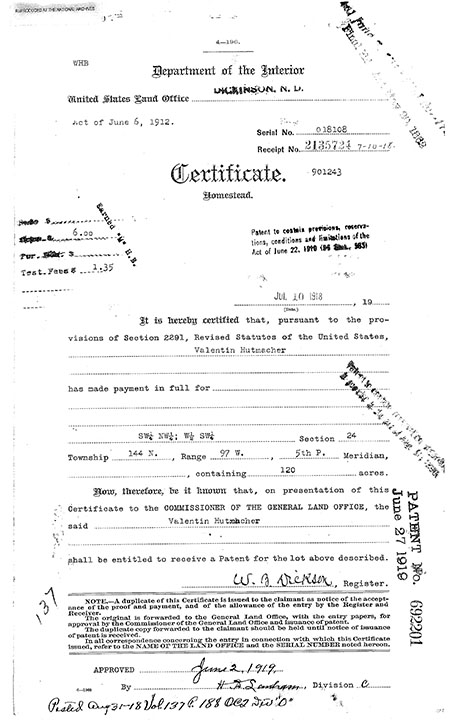The Homestead Act

Valentin Hutmacher's Homestead Certificate
The Homestead Act, passed by Congress in 1862, gave an applicant ownership of unsettled western land at little or no cost. A person could file a claim to unappropriated federal land up to 160 acres.
Men and single women over the age of twenty-one could make a homestead entry. Married women could not apply, but there was an exception for a woman who had been deserted by her husband.
Homesteaders "proved up" their claims if they lived on the land for a period of five years and could show evidence of having made improvements.
Valentine Hutmacher listed the following evidence of having made improvements on his homestead:
Cultivation
1913 - 24 acres, flax, 150 bu.1914 - 39 acres, flax, 100 bu wheat 200 bu.
1915 - 50 acres, flax, 96 bu. wheat 600 bu.
1916 - 60 acres, flax, 80 bu. wheat 350 bu.
1917 - 75 acres, flax, 86 bu. wheat 300 bu.
1918 - 75 acres, flax, wheat, oats not yet threshed.
Improvements
Stone House 16 x 30Stone Barn 16 x 40
Stone Granary 16 x 30
Stone Chicken Coop 6 x 12
Spring Well
40 acres fenced - 2 wire
Rules for Homesteading
North Dakota Magazine, ca. 1906;
No person who is the owner of more than 160 acres of land in any state or territory can acquire any right under the homestead law.
A man has to be twenty-one years of age to make an entry, unless he is married or the head of a family.
A married woman has no right to make a homestead entry. A deserted wife can make a homestead entry.
A single woman over the age of twenty-one years has the right to make a homestead entry.
A single woman does not forfeit her homestead entry by marriage if thereafter she continues to comply with the law as to residence, improvements and cultivation. But a husband and wife cannot both hold separate homestead entries and prove up on both.
The widow or children of a homesteader are not required to reside on their homestead after his death, but must continue cultivation by agent or otherwise. The widow can enter a homestead in her own right while cultivating that of her husband, in which event she must actually reside on the land entered in her own name.
Homestead entries cannot be made for more than 160 acres of land.
Five years' residence from date of entry is required on homesteads for perfecting the title, except that sailors or soldiers of the late war may apply, at time of residence, the period of their military service; but in all cases there must not be less than one year's actual residence on, and improvement of, the land.
After fourteen months' residence on a homestead the entry may be commuted, if desired, by paying $2.50 per acre, if within the Northern Pacific Railway land grant, 40 miles each side of the center of said railway track, or $1.25 per acre, if outside of said limit, and the government will then give patent.
Any person who entered less than 160 acres of land as a homestead before March 2, 1889, may now enter enough additional land which, added to the amount originally entered, will not exceed 160 acres.
A person who has not perfected title to a homestead entry, which he made prior to June 5, 1900, may make a new homestead entry of 160 acres, regardless of his previous filing.
Any person who, prior to June 5, 1900, commuted a homestead entry, may now take another homestead, but must reside on it five years. He cannot commute an entry again.
It is necessary to appear in person when making an entry of homestead lands.
Land office fees, when application is made for homestead entry, are as follows: $14 for 160 acres; $13 for 120 acres; $7 for 80 acres; $ 6 for 40 acres. If within the railroad land grant limit, $18 for 160 acre; $16 for 120 acres; $9 for 80 acres; $7 for 40 acres.
The Homestead Act

